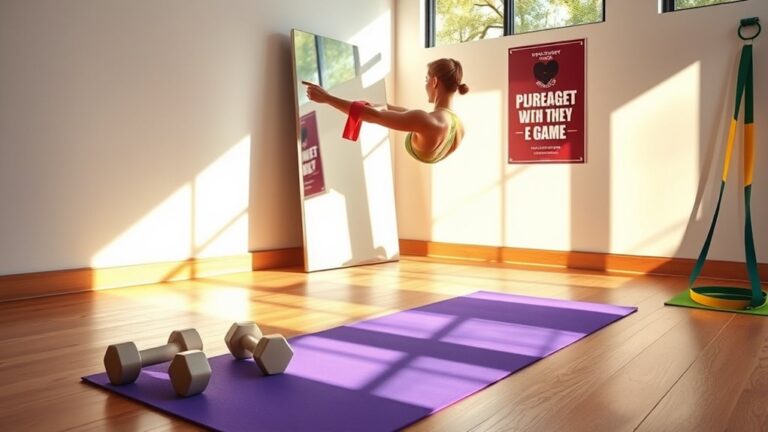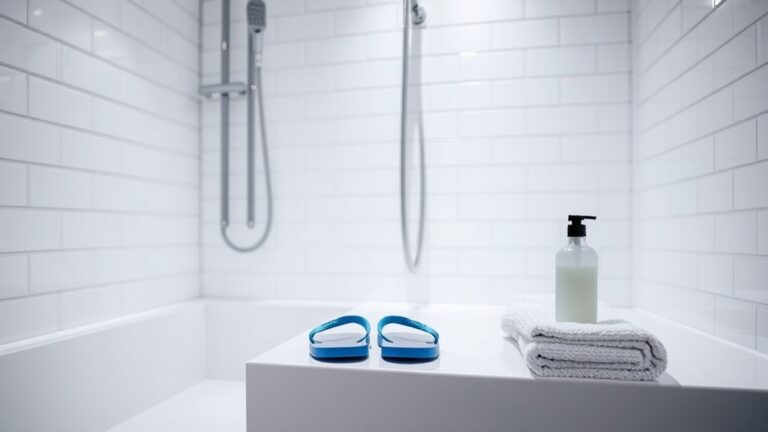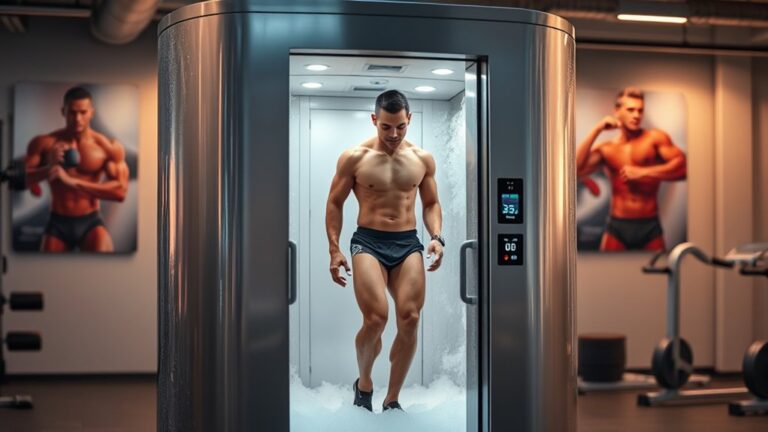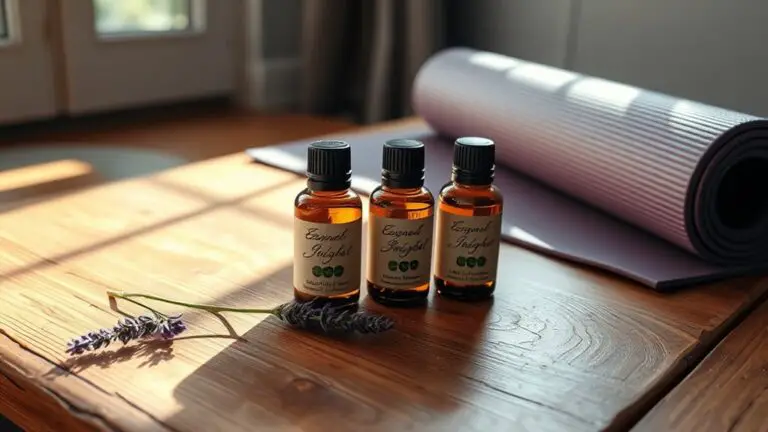How to Use Contrast Baths for Muscle Recovery
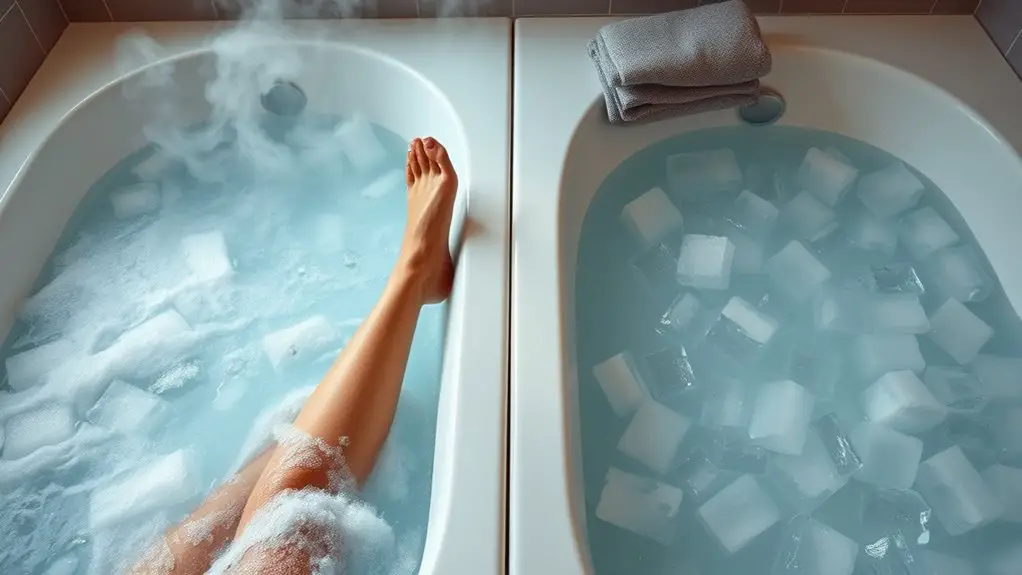
To use contrast baths for muscle recovery, fill one tub with warm water (100-110°F) and another with cold water (50-60°F). Immerse your target muscles in the warm bath for 3-4 minutes, then switch to the cold bath for 1 minute. Repeat this cycle 3-4 times, ending with cold immersion. Aim to start within 30 minutes post-exercise and consider doing this 2-3 times a week for ideal results. There’s much more to explore about maximizing your recovery.
Understanding Contrast Baths: The Science Behind the Method
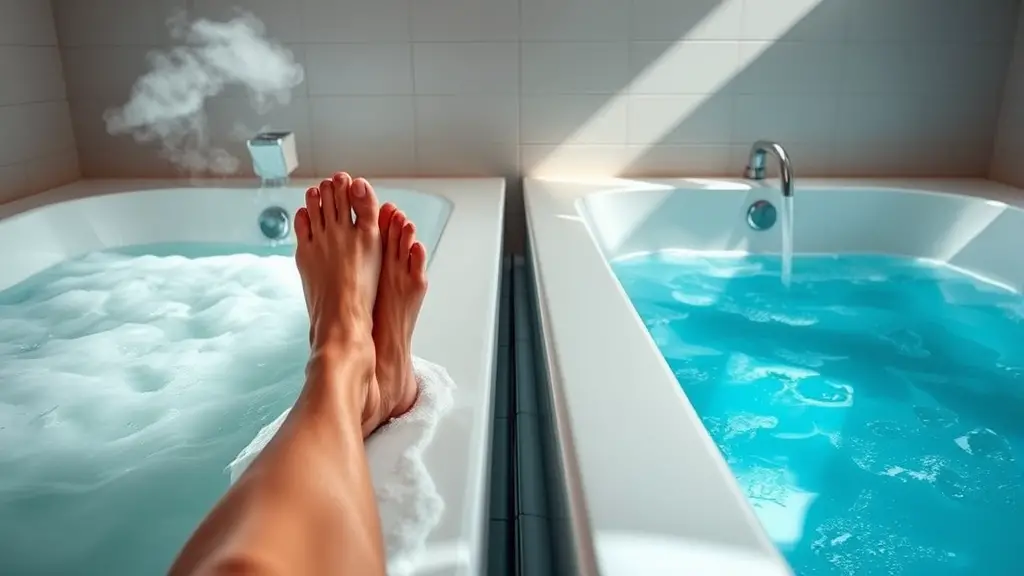
When you engage in intense physical activity, your muscles experience microtrauma, which can lead to soreness and delayed onset muscle soreness (DOMS). Contrast baths, alternating between hot and cold water, leverage physiological effects to enhance recovery. The warm water dilates blood vessels, promoting increased circulation and nutrient delivery to damaged tissues. Conversely, cold water constricts blood vessels, which helps reduce inflammation and metabolic waste.
This method also aids in temperature regulation. By exposing your muscles to varying temperatures, you stimulate thermoregulation, encouraging your body to adapt to extreme conditions. Research indicates that this alternating exposure may decrease muscle soreness and improve recovery times. Additionally, the physiological responses triggered by contrast baths can enhance your overall performance by preparing your muscles for subsequent workouts. Understanding these mechanisms can help you effectively incorporate contrast baths into your recovery regimen, optimizing your athletic performance and reducing the impact of DOMS.
Benefits of Contrast Baths for Muscle Recovery
While the practice of using contrast baths may seem simple, the benefits for muscle recovery are both significant and well-supported by research. By alternating between hot and cold water, you can effectively enhance your recovery techniques. Here are four key benefits you can expect:
- Reduced Muscle Soreness: Contrast baths help alleviate delayed onset muscle soreness (DOMS) by promoting circulation and flushing out metabolic waste.
- Improved Blood Flow: The temperature changes stimulate blood vessel dilation and constriction, enhancing nutrient delivery to your muscles.
- Enhanced Recovery Time: Regular use of contrast baths can accelerate recovery, allowing you to return to training sooner.
- Pain Relief: The contrasting temperatures can provide immediate pain relief by numbing nerve endings and reducing inflammation.
Incorporating contrast baths into your routine can be a valuable strategy for optimizing muscle recovery and minimizing discomfort after intense workouts.
Preparing for Your Contrast Bath Session
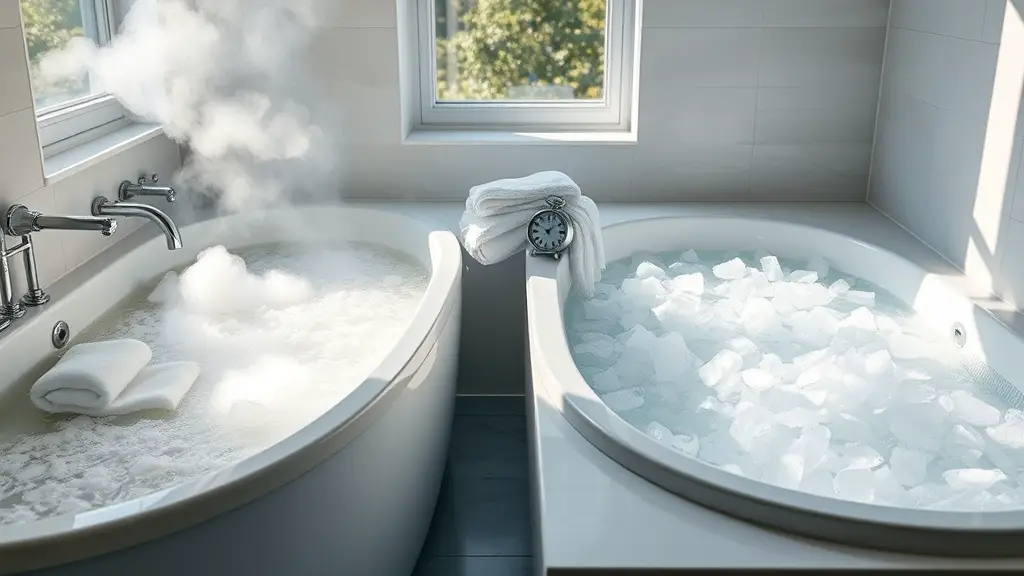
Before starting your contrast bath session, it is crucial to gather the necessary equipment, which typically includes two containers for hot and cold water. Aim for hot water around 100-110°F (37-43°C) and cold water at 50-60°F (10-15°C) to maximize the benefits of the treatment. Ensuring these temperature guidelines will help optimize your muscle recovery process.
Gather Necessary Equipment
To effectively prepare for your contrast bath session, you’ll need to gather a few essential pieces of equipment. Having the right contrast bath essentials guarantees that you maximize the benefits of this recovery technique. Here are the necessary supplies:
- Two containers: One for hot water (around 100-110°F) and one for cold water (50-60°F).
- Thermometer: To accurately measure the water temperatures.
- Towels: For drying off and to prevent slipping on wet surfaces.
- Timer: To keep track of your immersion intervals, typically alternating every 1-3 minutes.
Set Temperature Guidelines
Setting the right temperature is essential for an effective contrast bath session, as it directly impacts your muscle recovery. The ideal temperatures for contrast baths typically range from 50°F to 60°F (10°C to 15°C) for cold baths and 100°F to 110°F (38°C to 43°C) for warm baths. Using these temperature ranges helps stimulate blood circulation and reduce inflammation. You’ll want to alternate between these temperatures, typically spending 3–5 minutes in each bath. This method enhances the flushing of metabolic waste from your muscles while promoting nutrient delivery. Always listen to your body; if a temperature feels extreme or uncomfortable, adjust accordingly. Proper temperature management is vital for maximizing the benefits of your contrast bath routine.
Setting Up Your Contrast Bath: Equipment and Requirements
While preparing for contrast baths, you’ll need specific equipment and a suitable setup to maximize their effectiveness for muscle recovery. Proper equipment selection is essential for ideal bath preparation. Here’s what you’ll need:
- Two tubs: One filled with cold water (50-60°F) and another with warm water (100-110°F). Make sure they’re large enough for your limbs.
- Thermometer: To accurately measure and maintain water temperatures for both tubs.
- Timer: To keep track of the duration spent in each bath, typically alternating every 3-5 minutes.
- Towel: For drying off between baths, which helps maintain body temperature and comfort.
Setting up these elements correctly will not only enhance your recovery process but also guarantee that you’re safely reaping the benefits of contrast baths. With the right tools at your disposal, you’ll be well on your way to effective muscle recovery.
Step-by-Step Guide to Conducting a Contrast Bath
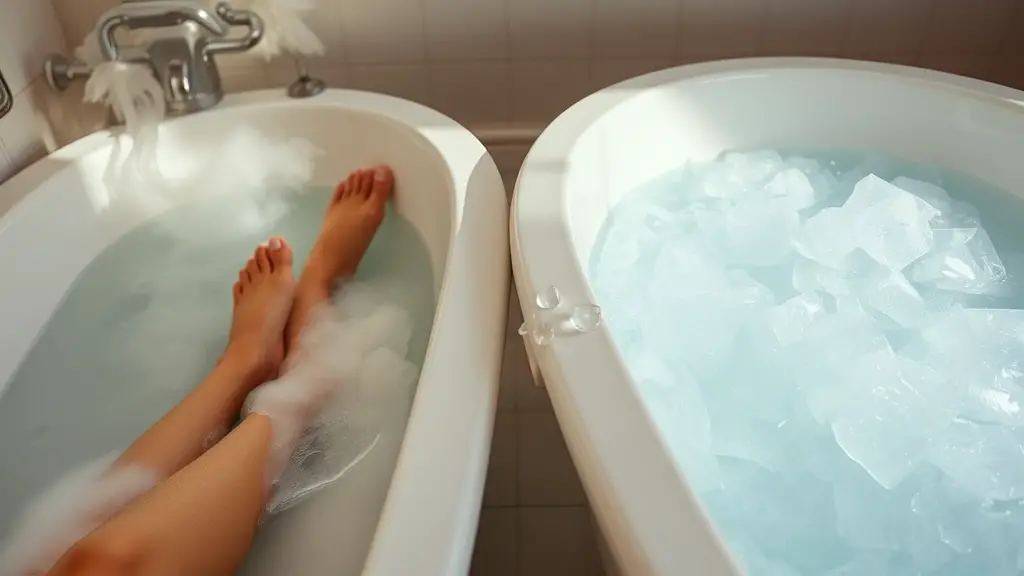
Conducting a contrast bath involves a straightforward process that can greatly enhance muscle recovery. Begin by preparing two containers: one with cold water (around 50°F) and another with warm water (about 100°F). Immerse your target muscles in the warm water for three to four minutes, allowing increased blood flow as per contrast theory. Next, switch to the cold water for one minute, which helps reduce inflammation and numb pain. Repeat this cycle for a total of three to four rounds, ensuring you’re ending with cold immersion to promote ideal recovery.
During each phase, focus on deep breathing to enhance relaxation, an essential component of effective recovery techniques. It’s important to monitor your body’s response throughout the process—if anything feels uncomfortable, adjust the temperature or duration accordingly. By following these steps diligently, you can leverage the benefits of contrast baths to support your muscle recovery effectively.
Recommended Duration and Frequency of Sessions
To maximize the benefits of contrast baths for muscle recovery, it’s crucial to evaluate the ideal session length and frequency of treatments. Research suggests that sessions lasting 15 to 20 minutes, alternating between hot and cold water, can enhance circulation and reduce muscle soreness. Additionally, timing your contrast baths within 24 hours after intense exercise can further improve recovery outcomes.
Optimal Session Length
Finding the right balance in session length is essential for maximizing the benefits of contrast baths in muscle recovery. Proper session timing and temperature balance enhance circulation and reduce muscle soreness. Here are some guidelines for ideal session length:
- Duration: Aim for 20-30 minutes total, alternating between hot and cold baths.
- Interval: Spend 3-4 minutes in each bath, ensuring sufficient exposure to both temperatures.
- Repetitions: Repeat the cycle 3-4 times to effectively stimulate blood flow.
- Cooling Down: Finish with a cold bath to help reduce inflammation and promote recovery.
Frequency of Treatments
Regularly incorporating contrast baths into your recovery routine can greatly enhance muscle repair and reduce soreness. To maximize benefits, adhere to frequency guidelines that suggest using contrast baths 2 to 3 times per week, especially after intense training sessions. Each treatment session should last around 20 to 30 minutes, alternating between hot and cold water every 3 to 5 minutes. These treatment recommendations align with studies indicating that alternating temperatures stimulate blood flow and reduce inflammation. It is crucial to listen to your body; if you experience excessive fatigue or discomfort, consider adjusting the frequency. Consistency will yield the best results, so find a schedule that works for you while ensuring adequate recovery between sessions.
Timing After Exercise
Timing is important when using contrast baths for ideal muscle recovery. Proper timing factors can greatly enhance your post-exercise recovery. Here’s how to optimize your sessions:
- Start Within 30 Minutes: Initiate contrast baths shortly after exercise to maximize benefits.
- Duration: Aim for 10-15 minutes total, alternating between hot and cold baths every 2-3 minutes.
- Frequency: Use contrast baths 2-3 times per week post-intensive workouts to promote muscle healing.
- Monitor Body Response: Adjust timing based on your individual recovery needs and any discomfort experienced.
Tips for Maximizing the Effectiveness of Contrast Baths
To maximize the effectiveness of contrast baths, it’s essential to pay attention to both temperature and duration. Aim for water temperatures around 50-60°F for cold baths and 100-110°F for hot baths. Alternate between these temperatures every 3-5 minutes, typically for a total duration of 15-30 minutes. This method promotes vasodilation and vasoconstriction, enhancing blood flow and aiding in muscle recovery.
Incorporating best practices involves ensuring you’re fully submerged to target the affected areas effectively. Pair contrast baths with other recovery techniques like hydration and proper nutrition to optimize results. Always listen to your body; if you experience discomfort, adjust temperatures or durations accordingly. Consider timing, too—using contrast baths within 24 hours post-exercise can yield the best outcomes. By adhering to these guidelines, you’ll enhance your recovery process, paving the way for improved performance and reduced muscle soreness.
Common Mistakes to Avoid When Using Contrast Baths
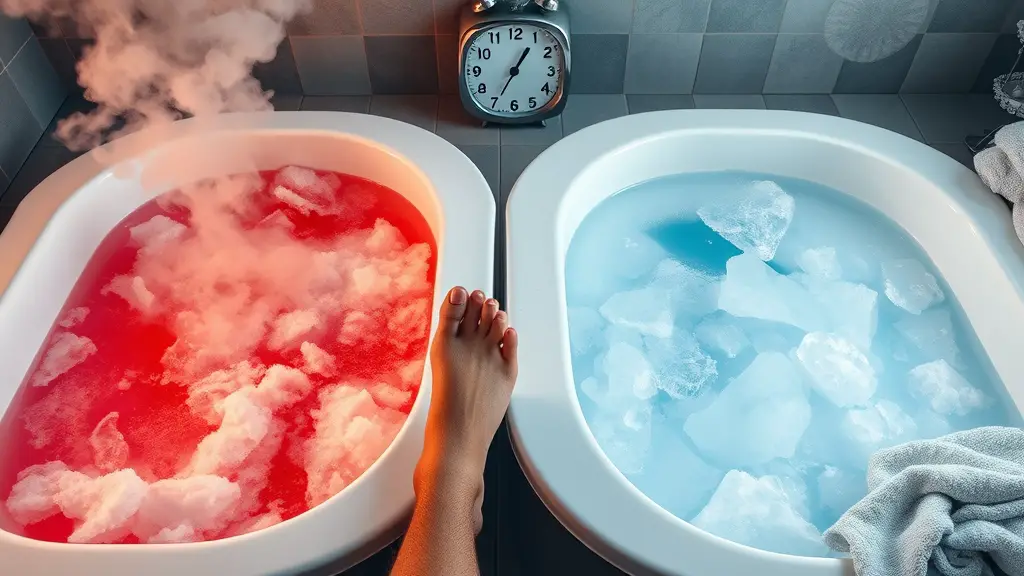
While using contrast baths can greatly enhance muscle recovery, several common mistakes can undermine their effectiveness. To guarantee you’re maximizing the benefits, avoid these pitfalls:
- Skipping Temperature Guidelines: Using water that’s too hot or too cold can lead to overheating issues or inadequate vasoconstriction, negating the desired effects.
- Improper Timing: Spending too little or too much time in each bath can disrupt the intended contrast effect. Aim for about 3-4 minutes in hot water followed by 1-2 minutes in cold.
- Neglecting Hydration: Failing to hydrate before and after sessions can lead to fatigue and hinder recovery, as your body needs fluids to function efficiently.
- Ignoring Personal Sensitivities: Not considering your individual tolerance levels can result in discomfort or injury, so always listen to your body’s signals.
Who Should Consider Using Contrast Baths?
Many athletes and active individuals can benefit from incorporating contrast baths into their recovery routines. If you’re involved in high-intensity sports or activities that put significant stress on your muscles, contrast baths may enhance your athletic performance by reducing muscle soreness and speeding up recovery. This method can help maintain peak physical condition, allowing you to train harder and more frequently.
Additionally, if you’re prone to injuries or aiming for injury prevention, contrast baths can facilitate improved circulation and lymphatic drainage, which aids in the healing process. They’re particularly effective for those recovering from soft tissue injuries or for individuals engaged in repetitive motions.
Before starting this recovery technique, consider consulting with a sports professional or physical therapist to confirm it’s appropriate for your specific needs. With the right application, contrast baths can be a valuable tool in your recovery arsenal.
Frequently Asked Questions
Can Contrast Baths Help With Joint Pain Relief?
When you’re dealing with joint pain, you want effective relief. Contrast baths can aid in pain management by reducing joint inflammation and promoting circulation. Alternating between hot and cold water stimulates blood flow, which may help alleviate discomfort. Research indicates that this method can enhance recovery and reduce stiffness, making it a viable option for managing your joint pain. If you’re looking for relief, consider incorporating contrast baths into your routine.
Are There Any Risks Associated With Contrast Baths?
When considering contrast baths, it’s essential to be aware of potential risks. You should take contrast bath precautions, especially if you have temperature sensitivity or circulatory issues. Rapid changes in temperature can lead to discomfort or exacerbate underlying conditions. Always monitor how your body responds, and consult a healthcare professional if you’re unsure. Staying within safe temperature ranges is vital to avoid adverse reactions during your recovery process.
How Does Temperature Affect Contrast Bath Effectiveness?
Imagine you’re an athlete using contrast baths after an intense workout. Temperature sensitivity plays a vital role in their effectiveness. Studies show that alternating between hot (around 104°F) and cold (50°F) baths can enhance recovery. Bath duration impacts this as well; typically, 3-4 minutes in hot water followed by 1-2 minutes in cold is recommended. This method promotes better circulation and reduces muscle soreness, optimizing your recovery process.
Can I Use Contrast Baths for Injury Rehabilitation?
Yes, you can use contrast baths for injury rehabilitation. This method leverages the contrast therapy benefits of alternating hot and cold water to enhance blood flow, reduce swelling, and alleviate pain. Incorporating contrast baths into your rehabilitation techniques can help expedite recovery by promoting muscle relaxation and improving flexibility. It’s essential to follow proper protocols to maximize effectiveness, ensuring you balance the temperatures to avoid any adverse effects during your recovery process.
What Should I Do if I Feel Faint During a Contrast Bath?
If you experience fainting symptoms during a contrast bath, it’s vital to stop immediately. Sit or lie down to prevent injury, and make certain the area is well-ventilated. Hydrate with water or an electrolyte drink to support recovery. Monitor your body’s response; if symptoms persist, seek medical assistance. Recovery tips include gradually acclimating to temperature changes and avoiding prolonged exposure to extreme temperatures to minimize the risk of dizziness or fainting.
